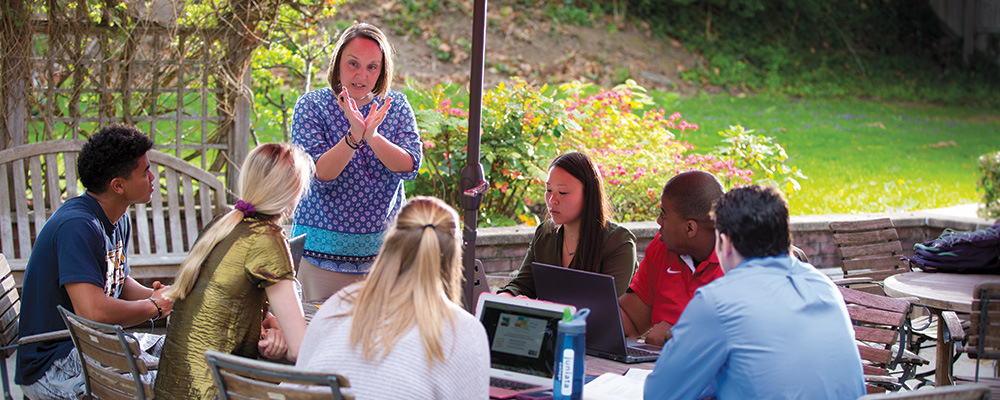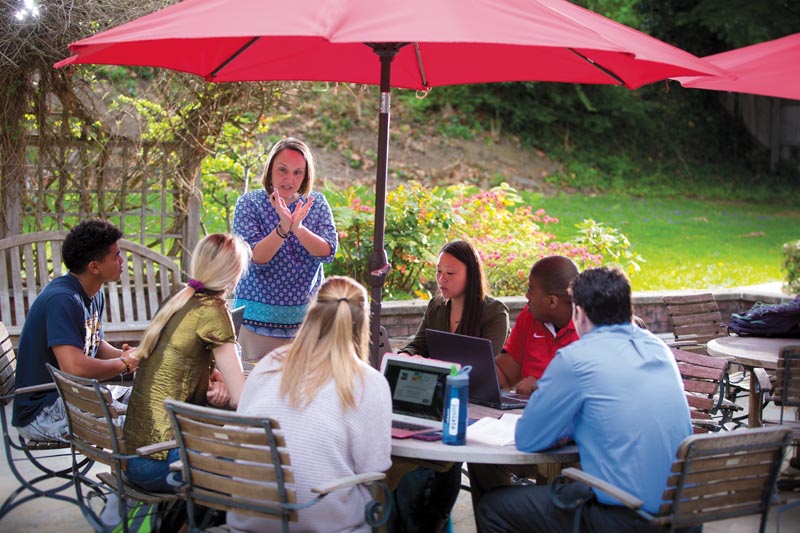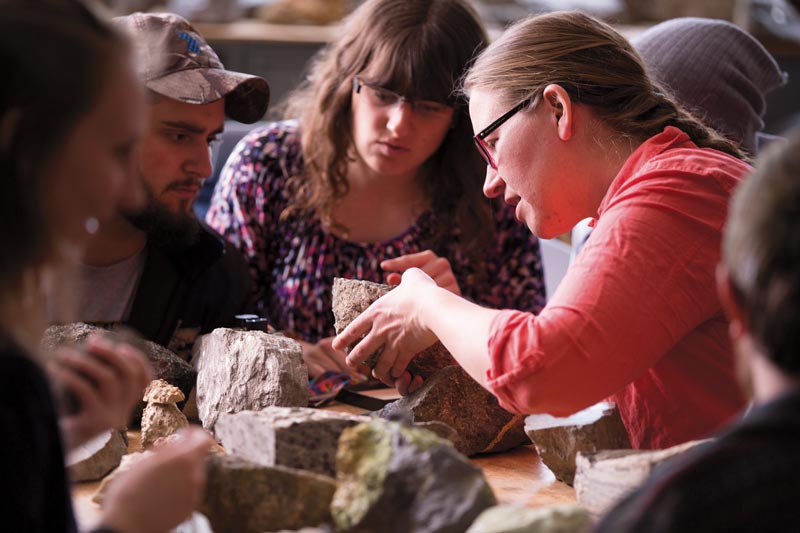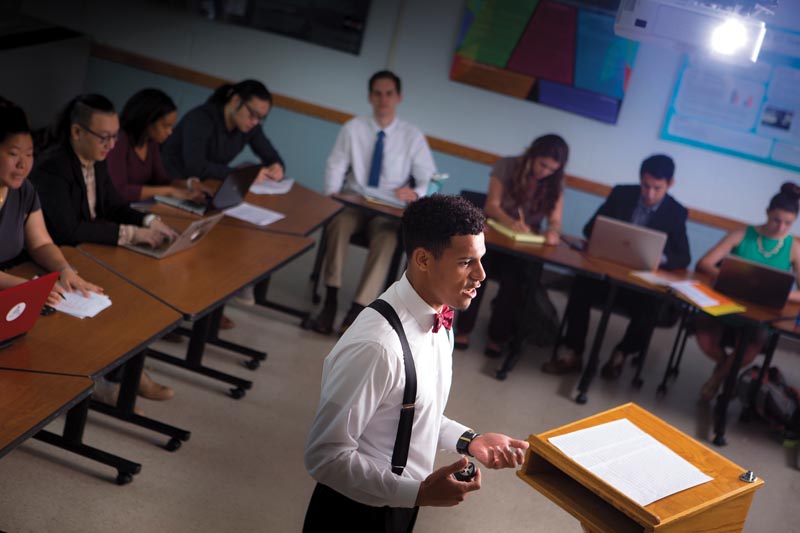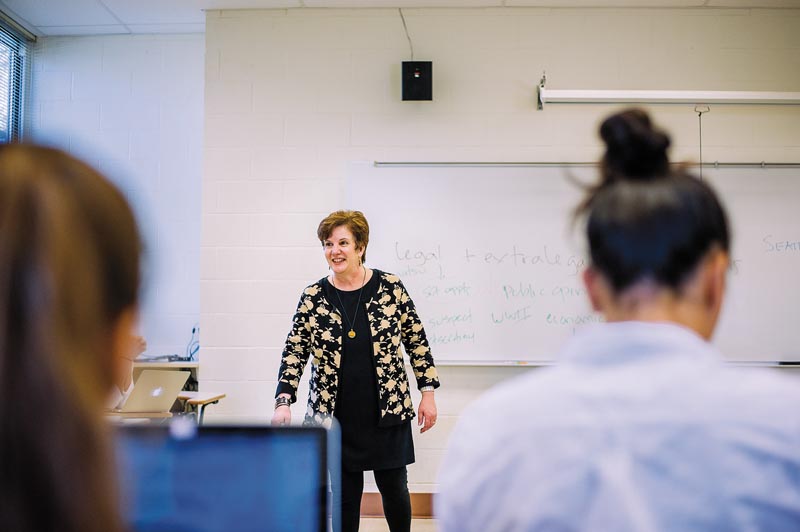A pressing challenge for students of today is to understand how to make sense of an onslaught of information, often from contradictory points of view, and to be able to engage with people they may or may never meet, and cultivate a critical eye.
Students often see Gen Ed as courses they have to check off the list before their real education begins. Juniata has never wanted that to be the case. Even in the days of Juniata’s “FISHN*” Gen Ed requirements and earlier, the goal of the College has always been to make each course relevant and worthwhile, and this new approach will enrich that effort.
*FISHN = Fine Arts, International, Social Science, Humanities, and Natural and Mathematical Sciences
No college course should merely be a box to check. Each should make a significant contribution to readying students’ hearts and minds for a lifetime of change and growth. It starts with confronting big questions: How will I choose to live my life? How will I choose to act in the world? How and with what tools will I understand the world?
With those questions in mind, Juniata set out to transform the College’s curricular model. The new Juniata College Curriculum passed overwhelmingly May 9, 2018, when it was put to a faculty vote (no small achievement). The new plan took effect in August. Here’s a look back at how the College blazed a new academic trail into the future for students and faculty alike.
“We asked ourselves, ‘What is it we want for Juniata students in this day and age?’ And we did that in a blank-slate way that was divorced from our current requirements, which allowed us to think big.”Phil Dunwoody, PROFESSOR OF PSYCHOLOGY
“The Curriculum we started with was more ‘check-boxy.’ There wasn’t as clear of a reason why you had to take a course, you just had to do it. Now, you can’t take just any class, you have to take one that fits into your Program of Emphasis.”Isabella “Izzy” Bennett ’20, POLITICS AND NON-PROFIT ORGANIZATION BALTIMORE, MD.
The Need for Change
Crucial to this work has been the awarding of three Andrew J. Mellon Foundation grants in 2014, 2017, and 2018, worth a combined $650,000, which funded the assessment, planning, and implementation necessary to revise the curriculum. An initial assessment of the existing model turned up multiple reasons a revision was in order, including the fact that it had far outlived the tenure of the faculty who developed it.
“The old curricular model predated the vast majority of faculty now teaching at Juniata,” says Phil Dunwoody, professor of psychology, director of assessment, and co-chair of the curriculum committee.
“So we were teaching to a model we never contributed to. The new Curriculum gives us a sense of ownership.”
And so Lauren Bowen, Juniata College provost and professor of politics, formed a committee of 12 faculty in February 2017. The committee set some ambitious objectives for the new curriculum to achieve, in light of the way life and work have changed. Juniata graduates need to enter the world having already learned how to engage with the unfamiliar, to understand how to adapt to fast-changing challenges, to collaborate in new ways—and to understand how learning itself works.
Later, the committee added students to the mix, including Isabella “Izzy” Bennett ’20. Bennett helped by getting feedback from students about what was being planned.
“We ran about 10 workshops with students,” Bennett says. “And then I took that back to the committee meetings and shared what the students’ concerns were.”
‘This Makes Juniata More Juniata’
Student feedback affirmed that the committee was on the right track.
“One of our students from our focus groups said, ‘This makes Juniata more Juniata,’” says Katy Johanesen, an assistant professor of geology who served on the Curriculum committee. “While the mechanics and names have changed, the school has not. The faculty is still affirming the liberal arts. It’s now better at supporting interdisciplinary connections.”
“The curriculum structure may be very new, but it’s a fulfillment of our unique identity as an institution. This is exactly what Juniata would do, because it’s who we’ve always been. We want to honor that tradition of responding to the need for change. To be timely. To continually ask ourselves, ‘How to prepare students for a world of work, but also for a life of meaning?’”
The Juniata College Curriculum Takes Shape
At its heart, the Curriculum is designed to equip students with useful knowledge and intellectual dexterity that they will take with them into their life’s work. This new approach will strengthen students’ ability to discern what knowledge means—and what they believe. To engage with unfamiliar situations and people, ask better questions, and to connect the dots among disparate disciplines that reinforce one another in surprising ways.
“We asked ourselves, ‘What is it we want for Juniata students in this day and age?’” Dunwoody says. “And we did that in a blank-slate way that was divorced from our current requirements, which allowed us to think big.”
Case in point, a course titled “Mars” that studies the Red Planet from both scientific and philosophical standpoints. Are we alone in the universe? If earth became uninhabitable, where would we go? What about this planet has sustained our collective curiosity? Is it possible to colonize Mars this century, why would we want to, and do we have the right?
“Mars” reflects how the new Curriculum approaches topics from multiple points of view—to fire up students’ brains from different angles. Built into the coursework is the idea that the school must make clear to students why they’re taking this course—something Dunwoody says they achieved by ensuring a “transparency of purpose.”
“We want to be clear with students, if we have a course requirement, why we had that requirement,” Dunwoody says. “It has to make sense.”
Students agree.
“The curriculum we started with was more ‘check-boxy’,” Bennett says. “There wasn’t a clear reason why you had to take a course, you just had to do it. Now, you can’t take just any class, you have to take one that fits into your Program of Emphasis (POE).”
Speaking of the POE, that remains the centerpiece of every Juniata student’s education. As always, the POE focuses on specific areas in which students earn their degree. The Curriculum complements the POE by providing context and by causing students to reflect more critically on their work.
Now, first-year students will write a paper about their values and goals. As they progress through the Curriculum, they will be questioned ever more deeply about what they believe, their ethics, their perspective—how they know what they know. This will be honed over all four years. Then, as seniors, they complete a capstone project in which they look back over their entire time at Juniata.
Leading up to the capstone project, the Curriculum also includes an online portfolio for each student to maintain, which houses their signature work and chronicles their growth throughout their years at Juniata. The portfolio is a manifestation of the authorship students have over the story of themselves that they write while at Juniata—and can continue to serve as a showcase of their accomplishments as they begin their professional lives. Students can curate their portfolio and choose what’s visible to whom, and share it with potential graduate schools or employers.
“While the mechanics and names have changed, the school has not. The faculty is still affirming the liberal arts. It’s now better at supporting interdisciplinary connections.”Katy Johanesen, ASSISTANT PROFESSOR OF GEOLOGY
“This Curriculum prepares students for a dynamic career. It’s designed to make them nimbler in today’s workplace. To adapt to change and to equip students with highly prized skills, from communicating to delivering presentations.”Lauren Bowen, PROVOST
“Each course requires students to submit a signature assignment to demonstrate progress on those outcomes,” Johanesen says. “Those will go into their portfolio. We’ll be able to grade them, but we can look at people’s progress from one year to the next, to see the change in students’ abilities over time.”
And those advances will be evident to future employers, too.
“This Curriculum prepares students for a dynamic career,” Bowen says. “It’s designed to make them nimbler in today’s workplace. To adapt to change and to equip students with highly prized skills, from communicating to delivering presentations.”
Engagement Is Front and Center
The Juniata Curriculum requires students to pursue engaging learning experiences in local communities through service, internships, or short projects—and to chronicle and reflect on those experiences. In fact, every student will meet some type of engagement requirement.
“Experiences matter,” Bowen says. “We’re here to see that students situate themselves in the world in which they live.
To provide students agency, so that they act in the world, they’re not acted upon by the world. The local and global engagement requirements help to get them there.”
Bennett, who recently completed a study abroad program in Cork, Ireland, echoes that value of engaging with the world.
“Engagement gives you a perspective beyond the college world,” Bennett says. “It’s really important for students to get that before they leave college. It can help you decide what you want to do afterward.”
“What we hear all the time from alumni is that mentoring by faculty was what really made the experience rich, and this new Curriculum will only strengthen that aspect.”Lauren Bowen, PROVOST
Highlights of the Juniata Curriculum
Centered on interdisciplinary inquiry and community engagement, the new Curriculum tackles why and how knowledge is created, evaluated, and used, and incorporates learning experiences outside the classroom. Here are some highlights.
First-Year Experience courses introduce students to the importance of reflecting on their values, beliefs, knowledge, and experiences as they transition into campus life. With heady titles like “The Good Life,” “Truth, Relativism, & Meaning,” and “Water Wars,” students contemplate what’s important to them, question their assumptions, zero in on moral dilemmas, and shape their powers of reasoning. “One of the things we built into it was the clear goal of having a more supportive first-year experience,” Dunwoody notes.
Ways of Knowing courses help students consider the world from different vantage points. “Students will look at how people in different fields know things, how they reason, collect evidence, create knowledge,” Johanesen says. “Ways of Knowing courses investigate how, for instance, a scientist is able to determine truth. So when you approach people in a given field, you know what questions to ask and you understand the answers.”
A Connections course presents a common topic from the perspective of two disciplines—co-taught by faculty who merge their different worlds in a way that expands students’ minds. “One feature everyone liked about our old model was the interdisciplinary colloquium and how it fosters a meeting of minds—taught by two faculty,” Johanesen says. “We’ve maintained that course in spirit and brought it into the new Curriculum.”
The Self and the World courses are designed to look less at disciplines and more at values, and in so doing, supporting students in finding their place in the world and understanding how to interact–respectfully–with people who are not the same as them. It fosters a sense of equal partnership with the people they’re serving. All of those components are related to the fact that we ask people to think about their place within the world, their community, family, and social structures. Not just as a thought experiment, but as a way to make decisions.
The Path Forward
When Johanesen and Dunwoody attended the Association of American Colleges & Universities (AAC&U) conference in February 2019 in San Francisco, they presented the Juniata College Curriculum to an audience of national colleagues who were wowed by their work—and on the College’s unique approach to an undertaking many colleges are tackling today.
“The way we went about the revision was special because of the strong tradition of consensus-building on campus,” Johanesen says. “There was a lot of faculty input and control, more than some schools might do. The community has to be part of the equation for it to be successful here. It has to have buy-in from the faculty. And that makes it a better curriculum because people believe in it.”
That goes for students, too. In fact, Johanesen and Dunwoody weren’t alone in their presentation to the AAC&U: they invited Juniata student Erik Rasmussen ’19, who had served on the curriculum committee, to speak.
“Having Erik at the conference blew people away because it showed the audience that the students are an important part of the process,” Johanesen says.
But Rasmussen’s inclusion at the event is standard operating procedure at Juniata. Which is why the new Curriculum had to be worthy of the mentorship that faculty have always offered to students. All feel that was accomplished.
“This new Curriculum reinforces one of our great strengths at Juniata: encouraging students to be in partnership with faculty. What we hear all the time from alumni is that mentoring by faculty was what really made the experience rich, and this new Curriculum will only strengthen that aspect,” says Bowen.
Faculty, students, and the place where they meet and collaborate matters. A curriculum that doesn’t serve that core value would never succeed at Juniata.
What will ultimate success look like?
“We’ll know this is working by the intellectual energy and questions students ask,” Bowen says. “By seeing students explore more outside their main interests. By looking at what they view as their signature work, the dynamism of those portfolios will be a marker of success.”
Of course, the ultimate marker of success will be to see what kind of citizens those students become.
“The tradition of the liberal arts is citizenship,” Dunwoody says. “What do citizens need to carry out their duties in society today? Our Curriculum is our answer to that question.”
